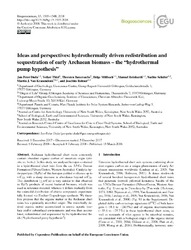Ideas and perspectives: hydrothermally driven redistribution and sequestration of early Archaean biomass – the “hydrothermal pump hypothesis”
Bauersachs, Thorsten
Mißbach, Helge
Reinhardt, Manuel
Schäfer, Nadine
Van Kranendonk, Martin J.
15, 5: 1535 - 1548
DOI: https://doi.org/10.5194/bg-15-1535-2018
Persistent URL: http://resolver.sub.uni-goettingen.de/purl?gldocs-11858/6545
Persistent URL: http://resolver.sub.uni-goettingen.de/purl?gldocs-11858/6545
Duda, Jan-Peter; Thiel, Volker; Bauersachs, Thorsten; Mißbach, Helge; Reinhardt, Manuel; Schäfer, Nadine; Van Kranendonk, Martin J.; Reitner, Joachim, 2018: Ideas and perspectives: hydrothermally driven redistribution and sequestration of early Archaean biomass – the “hydrothermal pump hypothesis”. In: Biogeosciences, Band 15, 5: 1535 - 1548, DOI: 10.5194/bg-15-1535-2018.
 |
Archaean hydrothermal chert veins commonly
contain abundant organic carbon of uncertain origin (abiotic
vs. biotic). In this study, we analysed kerogen contained
in a hydrothermal chert vein from the ca. 3.5 Ga Dresser
Formation (Pilbara Craton, Western Australia). Catalytic hydropyrolysis
(HyPy) of this kerogen yielded n-alkanes up to
n-C22, with a sharp decrease in abundance beyond n-C18.
This distribution ( n-C18) is very similar to that observed
in HyPy products of recent bacterial biomass, which was
used as reference material, whereas it differs markedly from
the unimodal distribution of abiotic compounds experimentally
formed via Fischer–Tropsch-type synthesis. We therefore
propose that the organic matter in the Archaean chert
veins has a primarily microbial origin. The microbially derived
organic matter accumulated in anoxic aquatic (surface
and/or subsurface) environments and was then assimilated,
redistributed and sequestered by the hydrothermal fluids
(“hydrothermal pump hypothesis”)
Statistik:
ZugriffsstatistikSammlung:
- Geologie [933]


